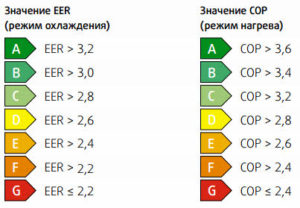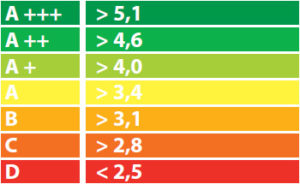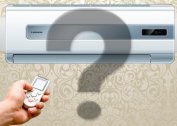With a competent approach to choosing an air conditioner, the energy efficiency class is one of the main criteria. This indicator determines the efficiency of climatic technology, the ratio of energy consumed to productivity in cold / heat. In Europe, seasonal coefficients SEER and SCOP have been developed, which allow comparing the energy efficiency of various models of climate technology in real conditions.
Energy Efficiency Indicators for Air Conditioners
 There are several factors to determine the energy efficiency of HVAC equipment. The main one, EER, refers to the ratio of cooling capacity to power consumption.
There are several factors to determine the energy efficiency of HVAC equipment. The main one, EER, refers to the ratio of cooling capacity to power consumption.
EER = Q (cold) / N (sweat)
Similarly, COP is calculated for the heating mode.
COP = Q (tep.) / N (sweat)
In simple words - the coefficients show the consumer how much heat / cold the split system produces at a flow rate of 1 kW of electricity. The higher the values obtained, the more efficient the air conditioner works with low current consumption.
For industrial air conditioning systems and heat pumps, the index is defined in KW / ton - consumed energy (kW) / cooling capacity (tonne of cooling). The ratio of the coefficients KW / ton = 12 / EER.
The operating conditions of HVAC equipment affect its performance and electricity consumption. Taking into account the load at the seasons, seasonal indicators have been developed.
EER coefficient
The most famous instant indicator associated with certain conditions, EER (Energy Efficiency Ratio). It is rated for rated operation under standard conditions. For household split systems, its value is from 2.5 to 3.5. The indicator is used in all countries, avoiding confusion with the labeling of equipment. The classification of air conditioners by energy efficiency classes is determined according to the EER index. They are assigned one of seven letter designations in the span of the English alphabet A-G. Class A appliances are characterized by low power consumption, EER 3.2. Class G is least effective, EER 2.2.
COP ratio
The thermal indicator COP (Coefficient of Performance) characterizes the ratio of heating performance to energy used. Its value for household split systems is 2.8-4.0. The heat index is higher than the cold index. This is due to the peculiarity of the technology. The included compressor heats up in any mode and transfers more heat to the freon than cold. The energy class of the air conditioner is determined by COP definition in seven categories from A to G. The calculated temperature is + 27 ° in the room. Standard street air data for reading:
- cooling - 35 ° C;
- heating - 7 ° C.
System power is maximum. To determine the actual energy efficiency of the equipment, seasonal indicators are called upon.
ESEER Seasonal Energy Efficiency Index
 ESEER's European Seasonal Energy Efficiency Index is set for various air conditioning systems, chillers and refrigeration equipment. It estimates the average value of the coefficient of cooling during operation with partial load. The calculation is carried out according to four operating modes. When measuring, climatic zones are taken into account. In Europe, there are three of them: warm, medium and cold. The breakdown was carried out conditionally, taking into account the amount in the heating mode used for the year. The received parameters, hour / year:
ESEER's European Seasonal Energy Efficiency Index is set for various air conditioning systems, chillers and refrigeration equipment. It estimates the average value of the coefficient of cooling during operation with partial load. The calculation is carried out according to four operating modes. When measuring, climatic zones are taken into account. In Europe, there are three of them: warm, medium and cold. The breakdown was carried out conditionally, taking into account the amount in the heating mode used for the year. The received parameters, hour / year:
- warm zone - 3590;
- middle zone - 4910;
- cold zone - 6446.
For the cooling mode, the average value is displayed - 2602 hours / year. On the climatic equipment informational sticker, a rule is stipulated by law to indicate SCOP seasonal energy efficiency factors only for the average climatic zone.
Seasonal ratios are calculated by national authorities. The basis of development are:
- statistical information on the load of air conditioning systems during the year;
- local climatic conditions;
- energy cost;
- class air conditioners.
The collected values for the load in graphical form represent a smooth curve. The generalized energy efficiency index is found by the formula: the integral of the load function divided by the duration of the period. Four-step averaging of the presented dependence simplifies calculations.
European marking alternative
Less common options for labeling the energy efficiency parameters of air conditioners are EMPE (Italy) and IPLV (USA).
Italian EMPE
Own method of energy efficiency of the chiller was developed by the Italian association AICARR, dealing with air conditioning systems. Its EMPE was derived for Eastern and Central Europe. Study conditions parameters:
- refrigerant flow rate does not change;
- inlet temperature stable - 7 ° C.
American IPLV
The IPLV Integral Coefficient is used in the United States market. The value of efficiency is determined at partial load. The indicator does not apply to central air conditioning systems. The calculation parameters stipulate that the period of operation with a high load of 75-100% is not more than 1%.
New energy efficiency indicators: SEER and SCOP
 Since 2013, EU countries have switched to a new designation for seasonal energy efficiency. For 11 years of use, the previously introduced energy labeling for air conditioners is outdated. No fundamental changes occurred, the first letter S was added to the usual abbreviation:
Since 2013, EU countries have switched to a new designation for seasonal energy efficiency. For 11 years of use, the previously introduced energy labeling for air conditioners is outdated. No fundamental changes occurred, the first letter S was added to the usual abbreviation:
- SERR - seasonal coefficient of operation in cooling mode;
- SCOP - seasonal coefficient for split systems operating for heating.
The new designations are used for domestic air conditioners with a cooling capacity of up to 12 kW.
The development of more advanced models of climate technology forced to change the classification of energy consumption. In addition to updating the labeling of seasonal indicators, several new energy efficiency classes were introduced: A +, A ++, A +++. Modern models have exceeded the parameters of their sector. The lower limit is now the energy efficiency class of the air conditioner D, classes E, F, G are canceled.
Which conditioner to buy
The best option for the ratio of energy spent and power generated are inverter air conditioners. Manufacturers of energy-efficient climate technology: Panasonic, Daikin, Mitsubishi Electric, Fujitsu. Equipment with a high SEER index is characterized by economical consumption of electricity, low noise, wide functionality. The disadvantage of split systems is the high cost. Have to pay in advance to save on operation.
A significant proportion of electricity consumption in developed countries is in air conditioning and ventilation systems. The introduction of stringent energy-saving requirements forced a review of the outdated EER, COP coefficients and replaced them with seasonal integrated indicators. Manufacturers modernized climate equipment, included intermediate sizes in the split-system line. The labels for air conditioners shipped to Europe indicate the energy class (A +++ to D) and the seasonal energy efficiency index for each EU climate zone.


